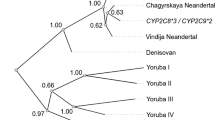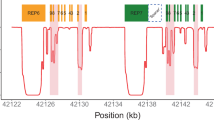Abstract
The cytochrome p450 enzyme, CYP2D6, metabolises approximately 20% of marketed drugs. CYP2D6 multiple variants are associated with altered enzyme activities. Genotyping 1018 Caucasians for CYP2D6 polymorphisms (G1846A, delT1707, delA2549 and A2935C), known to result in the recessive CYP2D6 poor drug metaboliser (PM) phenotype, identified 41 individuals with predicted PM phenotype. These 41 individuals were classified as ‘cases’. Single nucleotide polymorphisms (SNPs) mapping within an 880 kb region flanking CYP2D6, were identified to evaluate potential association between genetic variation and the CYP2D6 PM phenotype. The 41 PM cases and 977 controls were genotyped and analysed for 27 SNPs. Associations were observed across a 390 kb region between 14 SNPs and the PM phenotype (P values from 6.20 × 10−4 to 4.54 × 10−35). Haplotype analysis revealed more significant levels of association (P = 3.54 × 10−56). Strong (D′ > 0.7) linkage disequilibrium (LD) between SNPs was observed across the same 390 kb region associated with the CYP2D6 phenotype. The observed phenotype:genotype association reached genome-wide levels of significance, and supports the strategy for potential application of LD mapping and whole genome association scans to pharmacogenetic studies.
This is a preview of subscription content, access via your institution
Access options
Subscribe to this journal
Receive 6 print issues and online access
$259.00 per year
only $43.17 per issue
Buy this article
- Purchase on Springer Link
- Instant access to full article PDF
Prices may be subject to local taxes which are calculated during checkout




Similar content being viewed by others
References
Snarey A, Thomas S, Schneider M, Pound S, Barton N, Wright A et al . Linkage disequilibrium in the region of the autosomal dominant polycystic kidney disease gene (PDK1) Am J Hum Gen 1994 55: 365–371
Kerem B, Rommens J, Buchanan J, Markiewicz D, Cox T, Chakravarti A . Identification of the cystic fibrosis gene: genetic analysis Science 1989 245: 1073–1080
Kruglyak L . Prospects for whole-genome linkage disequilibrium mapping of common disease genes Nat Gen 1999 22: 139–144
Rannala B, Reeve J . High resolution multipoint linkage-disequilibrium mapping in the context of a human genome sequence Am J Hum Gen 2001 69: 159–178
Martin E, Gilbert J, Lai, Riley J, Rogala A, Slotterback B et al . Analysis of association at single nucleotide polymorphisms in the APOE region Genomics 2000 63: 7–12
Horikawa Y, Oda N, Cox N, Li X, Orho-Melander M, Hara M et al . Genetic variation in the gene encoding calpain-10 is associated with type 2 diabetes mellitus Nat Genet 2000 26: 163–175
Rioux J, Daly M, Silverberg M, Lindblad K, Steinhart H, Cohen Z et al . Genetic variation in the 5q31 cytokine gene cluster confers susceptibility to Crohn disease Nat Genet 2001 29: 223–228
McCarthy L, Hosford D, Riley J, Bird M, White N, Hewett D et al . Single nucleotide polymorphism alleles in the insulin receptor are associated with typical migraine Genomics 2001 78: 135–149
Risch N, Merikangas K . The future of genetic studies of complex human diseases Science 1996 27: 1516–1517
Marshall E . Drug firms to create public database of genetic mutations Science 1999 284: 406–407
Cardon L, Bell J . Association study designs for complex diseases Nat Rev Genetics 2001 2: 91–99
Elston R, Idury R, Cardon L, Lichter J . The study of candidate genes in drug trials: sample size considerations Statistics in Medicine 1999 18: 741–751
Kuivenhoven J, Jukema J, Zwinderman A, de Knijff P, McPherson R, Bruschke A et al . The role of a common variant of the cholesteryl ester transfer protein gene in the progression of coronary atherosclerosis. The Regression Growth Evaluation Statin Study Group New Eng J Med 1998 338: 86–93
Nebert D . Polymorphisms in drug-metabolising enzymes: what is their clinical relevance and why do they exist? Am J Hum Gen 1997 60: 265–271
Evans W, Relling M . Pharmacogenomics: translating functional genomics into rational therapeutics Science 2000 286: 487–491
Marez D, Legrand M, Sabbagh N, Guidice J, Spire C, Lafitte J et al . Polymorphism of the cytochrome P450 CYP2D6 gene in a European population: characterisation of 48 mutations and 53 alleles, their frequencies and evolution Pharmacogenetics 1997 7: 193–202
Griese E, Zanger U, Brudermanns U, Gaedigk A, Mikus G, Morike K et al . Assessment of the predictive power of genotypes for the in-vivo catalytic function of CYP2D6 in a German population Pharmacogenetics 1998 8: 15–26
Stuven T, Griese E, Kroemer H, Eichelbaum M, Zanger U . Rapid detection of CYP2D6 null alleles by long-distance and multiplex-polymerase chain reaction Pharmacogenetics 1996 6: 417–421
Sachse C, Brockmoller J, Bauer S, Roots I . Cytochrome P450 2D6 variants in a Caucasian population: allele frequencies and phenotypic consequences Am J Hum Gen 1997 60: 284–295
Reich D, Cargill M, Bolk S, Ireland J, Sabeti P, Richter D et al . Linkage disequilibrium in the human genome Nature 2001 411: 199–204
Daly M, Rioux J, Schaffner S, Hudson T, Lander E . High-resolution haplotype structure in the human genome Nat Genet 2001 29: 229–232
Taillon-Miller P, Bauer-Sardina I, Saccone N, Putzel J, Laitinen T, Cao A et al . Juxtaposed regions of extensive and minimal linkage disequilibrium in human Xq25 and Xq28 Nat Genet 2000 25: 324–328
Moffatt M, Traherne J, Abecasis G, Cookson W . Single nucleotide polymorphism and linkage disequilibrium within the TCR alpha/delta locus Hum Mol Gen 2000 9: 1011–1019
Abecasis G, Noguchi E, Heinzmann A, Traherne J, Bhattacharyya S, Leaves N et al . Extent and distribution of linkage disequilibrium in three genomic regions Am J Hum Gen 2001 68: 191–197
Martin E, Lai E, Gilbert J, Rogala A, Afshari A, Riley J et al . SNPing away at complex diseases: analysis of single nucleotide polymorphisms around APOE in Alzheimer's disease Am J Hum Gen 2000 67: 383–394
Zollner S, von Haeseler A . A coalescent approach to study linkage disequilibrium between single nucleotide polymorphisms Am J Hum Gen 2000 66: 615–628
Yu A, Zhao C, Fan Y, Jang W, Mungall A, Deloukas P . Comparison of human genetic and sequence-based physical maps Nature 2001 409: 951–953
Roses A . Pharmacogenetics and the practice of medicine Nature 2000 405: 857–865
Lee F, Zhao B, Seow-Choen F . Relationship between polymorphism of N-acetyltransferase gene and susceptibility to colorectal carcinoma in a Chinese population Pharmacogenetics 1998 8: 513–517
Braun A, Little D, Koster H . Detecting CFTR gene mutations by using primer oligo base extension and mass spectrometry Clin Chem 1997 43: 1151–1158
Little D, Cornish T, O'Donnel M, Braun A, Cotter R, Koester H . MALDI on a chip: analysis of arrays of low-femtomole to subfemtomole quantities of synthetic oligonucleotides and DNA diagnostic products dispensed by a piezoelectric pipet Anal Chem 1997 69: 4540–4546
Ross P, Hall L, Smirnov I, Haff L . High level multiplex genotyping by MALDI-TOF mass spectrometry Nat Biotechnol 1998 16: 1347–1351
Livak K, Marmaro J, Todd J . Towards fully automated genome-wide polymorphisms screening Nat Genet 1995 9: 341–342
Lewontin R . The interaction of selection and linkage Genetics 1964 49: 49–67
Mehta C, Patel N . A network algorithm for performing Fisher's exact test in r × c contingency tables J Am Stat Assoc 1983 78: 427–434
Westfall P, Zaykin D, Young S . Biostatistical Methods Humana Press: New Jersey 2001
Demptser A, Laird N, Rubin D . Maximum likelihood from incomplete data via the EM algorithm J Royal Stat Soc 1977 39: 1–38
D'Agostino R . Relation between the chi-squared and ANOVA tests for testing equality of k independent dichotomous populations The American Stat 1972 26: 30–32
Weir BS . Genetic Data Analysis II Sinauer Associates: Massachusetts 1996
Acknowledgements
We would like to thank Shela Varsani and Ros Cutts for data handling, Mike Stubbins for helpful discussions about the CYP2D6 variants, and Dmitri Zaykin for help with the haplotyping methodology. We thank Linda McCarthy for her critical reading of the manuscript. We are grateful for the GSK sequencing group for the assistance in identification and verification of the SNPs, and Yingkun Brunner, Dajana Preuss and Elvira Deravanessian for assistance with the MALDI-TOF genotyping.
Author information
Authors and Affiliations
Corresponding author
Rights and permissions
About this article
Cite this article
Hosking, L., Boyd, P., Xu, C. et al. Linkage disequilibrium mapping identifies a 390 kb region associated with CYP2D6 poor drug metabolising activity. Pharmacogenomics J 2, 165–175 (2002). https://doi.org/10.1038/sj.tpj.6500096
Received:
Revised:
Accepted:
Published:
Issue Date:
DOI: https://doi.org/10.1038/sj.tpj.6500096
Keywords
This article is cited by
-
Molecular identification and population structure of emmer and einkorn wheat lines with different ploidy levels using SSR markers
Genetic Resources and Crop Evolution (2024)
-
Linkage disequilibrium under polysomic inheritance
Heredity (2022)
-
Fine-scale mapping of disease susceptibility locus with Bayesian partition model
Genes & Genomics (2012)
-
Factors affecting the effective number of tests in genetic association studies: a comparative study of three PCA-based methods
Journal of Human Genetics (2011)
-
Genetic polymorphism, linkage disequilibrium, haplotype structure and novel allele analysis of CYP2C19 and CYP2D6 in Han Chinese
The Pharmacogenomics Journal (2009)



